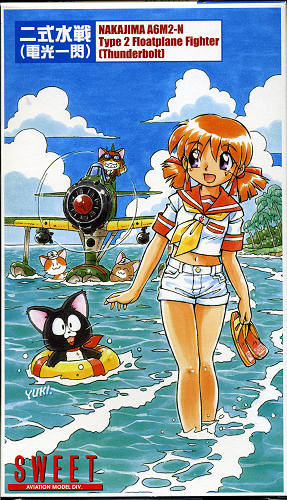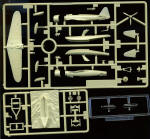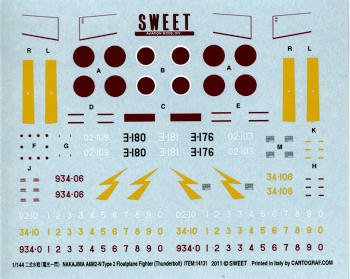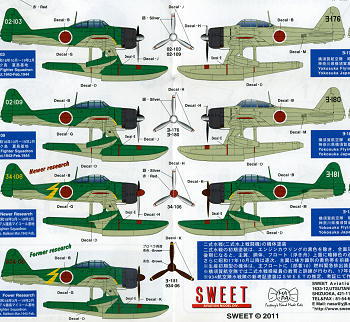
Sweet 1/144 A6M2-N "Thunderbolt"
| KIT #: | 14131 |
| PRICE: | 1600 yen from HLJ (about $20.50) |
| DECALS: | Seven options |
| REVIEWER: | Scott Van Aken |
| NOTES: | New tool kit |

| HISTORY |
The aircraft was deployed in 1942, referred to as the "Suisen 2" ("Hydro fighter type 2"), and was only utilized in defensive actions in the Aleutians and Solomon Islands operations. Such seaplanes were effective in harassing American PT boats at night, and they were very difficult to detect, even with primitive radar. Close misses killed officers and crews of boats such as PT 105. They could also drop flares to illuminate the PTs which were vulnerable to destroyer gunfire, and depended on cover of darkness. Since the boats left a phosphorescent wake which was visible from the air, they would leave their engines in idle to minimize this. It was primarily for this reason that John F. Kennedy's PT 109 was caught off guard in idle and rammed by the destroyer Amagiri, unable to maneuver out of the way in time.
The seaplane also served as an interceptor for protecting fueling depots in Balikpapan and Avon Bases (Dutch East Indies) and reinforced the Shumushu base (North Kuriles) in the same period. Such fighters served aboard seaplane carriers Kamikawa Maru in the Solomons and Kuriles areas and aboard Japanese raiders Hokoku Maru and Aikoku Maru in Indian Ocean raids. In the Aleutian Campaign this fighter engaged with Lockheed P-38 Lightning fighters and Boeing B-17 Flying Fortress bombers. The aircraft was used for interceptor, fighter-bomber, and short reconnaissance support for amphibious landings, among other uses.
Later in the conflict the Otsu Air Group utilized the A6M2-N as an interceptor alongside Kawanishi N1K1 Kyofu ("Rex") aircraft based in Biwa lake in the Honshū area.
The last A6M2-N in military service was a single example recovered by the French forces in Indochina after the end of World War II. It crashed shortly after being overhauled.
The large float and wing pontoons of the A6M2-N degraded its performance by about 20%, enough that the A6M2-N was not usually a match for even the first generation of Allied fighters.
| THE KIT |
 Once
again, our friends at Sweet have done another fine twin pack kit. This time, it
is the Nakajima A6M2-N 'Rufe'. This is the 'comic boxing' with Yuki and her
feline ground crew. While the box art is a real move away from the reality of
World War II, the kit inside is not.
Once
again, our friends at Sweet have done another fine twin pack kit. This time, it
is the Nakajima A6M2-N 'Rufe'. This is the 'comic boxing' with Yuki and her
feline ground crew. While the box art is a real move away from the reality of
World War II, the kit inside is not.
Molded in a cream colored plastic, the detail level is what we have come to expect from Sweet. The interior is pretty much just a seat with the antenna behind it. A fair representation of the motor is provided to place in the one piece cowling. The wing is a single piece with gun inserts. Each wing tip float is two pieces. The main float is two large sections with the rear bracing. One needs to put some weight in the forward portion of the float, though no amount is specified. To put under the wings are a pair of bombs. These already have the holes drilled for them in the lower wing so one will need to fill those if not using the bombs.
There are two ways to display the finished model. One is to build up the seven piece beaching trolley. The other is to use the small section of water that is provided with the kit.

 There
are seven markings options in this one (actually more as you have a bunch of
individual numbers you can use). Two of them, from the Yokosuka Flying Group are
in the greyish scheme and do not have the yellow wing ID markings. There is also
a green/grey option from this unit later in the war. The rest are all
green/grey. Two options are from the 902nd Flying Group from Truk in the
Carolines. The other two are from the 934th Flying Group at Enu Island. These
have the large yellow lightning bolt on the fuselage. Actually these two are the
same plane. One the result of earlier research with the second a more current
research find. The latter has a red spinner. Sweet's decals are printed by
Cartograf and provide all the markings you need, including the wing ID stripes.
I have darkened the sheet to try to show the white markings.
There
are seven markings options in this one (actually more as you have a bunch of
individual numbers you can use). Two of them, from the Yokosuka Flying Group are
in the greyish scheme and do not have the yellow wing ID markings. There is also
a green/grey option from this unit later in the war. The rest are all
green/grey. Two options are from the 902nd Flying Group from Truk in the
Carolines. The other two are from the 934th Flying Group at Enu Island. These
have the large yellow lightning bolt on the fuselage. Actually these two are the
same plane. One the result of earlier research with the second a more current
research find. The latter has a red spinner. Sweet's decals are printed by
Cartograf and provide all the markings you need, including the wing ID stripes.
I have darkened the sheet to try to show the white markings.
| CONCLUSIONS |
These truly are pretty easy to build and though masking a 1/144 greenhouse canopy can seem daunting, it can be either hand painted or done with thin decal stripes pre-painted with the camouflage color. A great set of models for the very small scale builder.
| REFERENCES |
http://en.wikipedia.org/wiki/Nakajima_A6M2-N
December 2011 Thanks to
www.hlj.com
for the preview kit. Get yours
here.
If you would like your product reviewed fairly and fairly quickly, please contact the editor or see other details in the
Note to
Contributors.